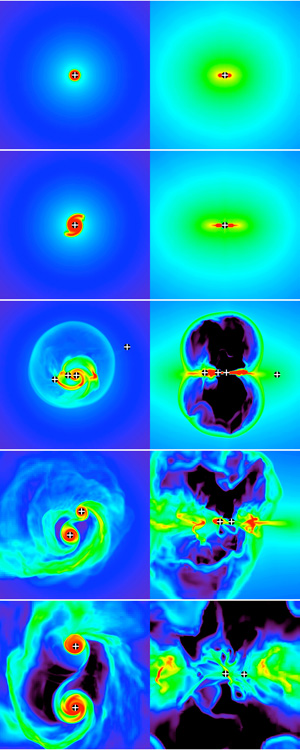Observations, however, show that stars exist with masses above the theoretical threshold and often coexist with other massive stars in binary systems - providing a mystery to astrophysicists until now.
As material begins to gravitationally attract into a star, the pressure inside the core eventually becomes sufficiently high so that gases compress and nuclear fusion (the fusing of hydrogen atoms into helium atoms) begins. Each miniature fusion reaction creates a photon of light, which shoots outward from the star and causes the shine that is observable from outside. Photons, although massless, are capable of imparting energy to other atoms and molecules, and a photon speeding quickly out of a star pushes atoms in its direction of motion.
Collectively this is called radiation pressure, and it acts as a repulsive force coming from inside the star.

Simulated Starbirth: The new computer simulation ORION shows
how two very massive stars can form despite the fact that radiation
pressure from inside the star is stronger than gravity, and should
therefore prevent the star from forming. Frames on the left look "down" on the stars with the axis of rotation perpendicular to the page, while those on the right show an equatorial view. Photo Credit: University of California, Santa Cruz
For small- and medium-sized stars (any star whose mass is less than about 20 solar masses) radiation pressure exists but has less of an effect than gravity. However, when the amount of material present exceeds about 20 solar masses the amount of radiation pressure in the core should build too quickly for the star to completely form. High radiation pressure early on should exceed the gravitational attraction required to pull additional material into the star, halting formation and eventually blowing the remaining material out to space. This expected result has long puzzled astronomers, who have found stars containing 120 solar masses - far above the predicted result.
Now, a more accurate simulation, developed by Lawrence Livermore National Laboratory, University of California, Santa Cruz, and UC Berkeley, has shown how such massive stars can form despite the huge amount of radiation pressure present and that they form readily in pairs, instead of alone.
"Originally, we were just exploring the physics of massive star formation," Livermore's Richard Klein said. "As we were looking at the physics, we found that gravitational instabilities cause companion stars to form around massive stars."
The team spent years developing code that adds an additional level of complexity to previous simulations - a third dimension. Called ORION, the code simulated the effects of a disk of slowly rotating gas with a total mass of 100 solar masses over a period of 57,000 years. The computer performed trillions of calculations at a set of discrete time steps to determine the properties of the simulated material as it collapsed into a star.
"Logically, we thought the massive amounts of radiation pressure would stop the star in its tracks from growing any larger," Klein said. "But instead, gravitational instabilities channeled gas onto the star system through disks and filaments, sort of like fingers, that self-shield against the radiation, while allowing the radiation to escape through optically thin bubbles."
When averaged over the entire spherical surface, the force of radiation pressure in the three-dimensional simulation still exceeds the force of gravity. What the two-dimensional simulations never showed, however, were large amounts of material condensed into filaments streaming downward toward the star unaffected by the radiation pressure - providing a net increase in the mass of the star. But to the surprise of the researchers, most of this material ended up in the disk surrounding the star and eventually formed two additional "protostars," one of which slammed back into the original star. When all was said and done, two very massive stars - one containing 41.5 solar masses and one containing 29.2 - sat orbiting one another.
The simulation answers a number of questions about star formation, but there are many mysteries that still rule the cosmos. We can only hope that there are more computer simulations as enlightening as this one coming soon.
---
A full animation of the simulation can be seen here.





Comments